Page 419 of 569

418 Practical hints
What to do if …
ProblemPossible cause/conse-
quenceSuggested solution
?(USA only)
±(Canada only)
The yellow engine malfunction
indicator lamp comes on while
driving.A loss of pressure has been
detected in the fuel system.
The fuel cap may not be closed
properly or the fuel system
may be leaky.�Check the fuel cap (�page 352).
If it is not closed properly:
�Close the fuel cap.
If it is closed properly:
�Have the fuel system checked by an
authorized Mercedes-Benz Light Truck
Center.
Vehicles with diesel engine
only:
Your fuel tank is empty.�After refueling start, turn off and
restart the engine three or four times in
succession.
The limp-home mode is canceled. You do
not need to have your vehicle checked.
lThe red distance warning lamp comes on
while driving and you hear a warning sound.You are gaining too rapidly on
the vehicle ahead of you.�Apply the brakes immediately.
�Carefully observe the traffic situation.
You may need to brake or maneuver to
avoid hitting an obstacle.
The Distronic* has recognized
a stationary obstacle on your
probable line of travel.
Page 424 of 569
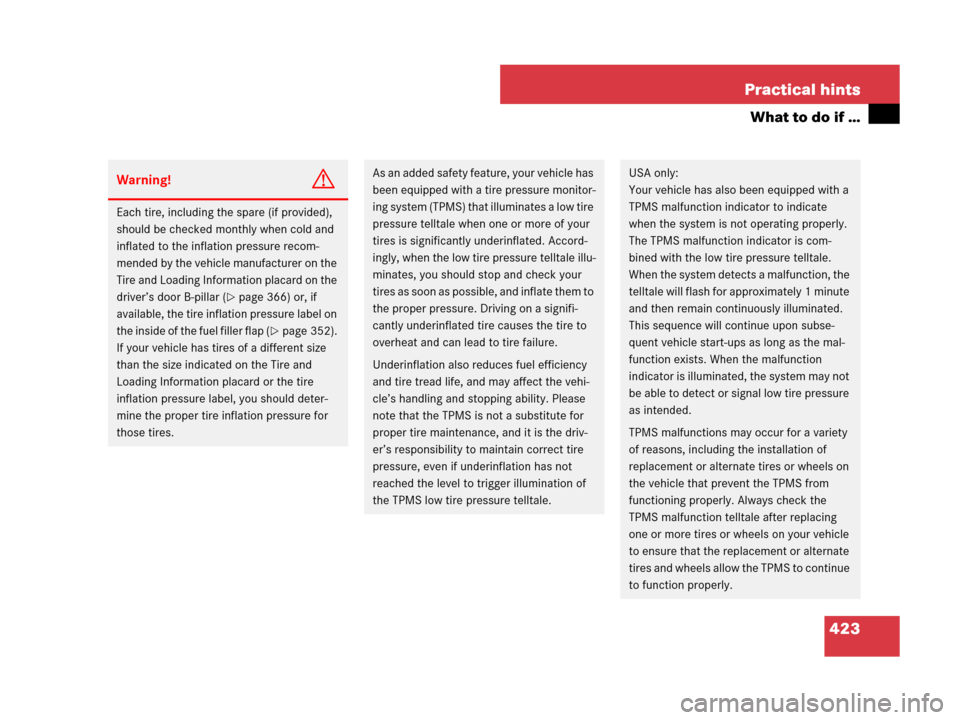
423 Practical hints
What to do if …
Warning!G
Each tire, including the spare (if provided),
should be checked monthly when cold and
inflated to the inflation pressure recom-
mended by the vehicle manufacturer on the
Tire and Loading Information placard on the
driver’s door B-pillar (
�page 366) or, if
available, the tire inflation pressure label on
the inside of the fuel filler flap (
�page 352).
If your vehicle has tires of a different size
than the size indicated on the Tire and
Loading Information placard or the tire
inflation pressure label, you should deter-
mine the proper tire inflation pressure for
those tires.
As an added safety feature, your vehicle has
been equipped with a tire pressure monitor-
ing system (TPMS) that illuminates a low tire
pressure telltale when one or more of your
tires is significantly underinflated. Accord-
ingly, when the low tire pressure telltale illu-
minates, you should stop and check your
tires as soon as possible, and inflate them to
the proper pressure. Driving on a signifi-
cantly underinflated tire causes the tire to
overheat and can lead to tire failure.
Underinflation also reduces fuel efficiency
and tire tread life, and may affect the vehi-
cle’s handling and stopping ability. Please
note that the TPMS is not a substitute for
proper tire maintenance, and it is the driv-
er’s responsibility to maintain correct tire
pressure, even if underinflation has not
reached the level to trigger illumination of
the TPMS low tire pressure telltale.USA only:
Your vehicle has also been equipped with a
TPMS malfunction indicator to indicate
when the system is not operating properly.
The TPMS malfunction indicator is com-
bined with the low tire pressure telltale.
When the system detects a malfunction, the
telltale will flash for approximately 1 minute
and then remain continuously illuminated.
This sequence will continue upon subse-
quent vehicle start-ups as long as the mal-
function exists. When the malfunction
indicator is illuminated, the system may not
be able to detect or signal low tire pressure
as intended.
TPMS malfunctions may occur for a variety
of reasons, including the installation of
replacement or alternate tires or wheels on
the vehicle that prevent the TPMS from
functioning properly. Always check the
TPMS malfunction telltale after replacing
one or more tires or wheels on your vehicle
to ensure that the replacement or alternate
tires and wheels allow the TPMS to continue
to function properly.
Page 425 of 569
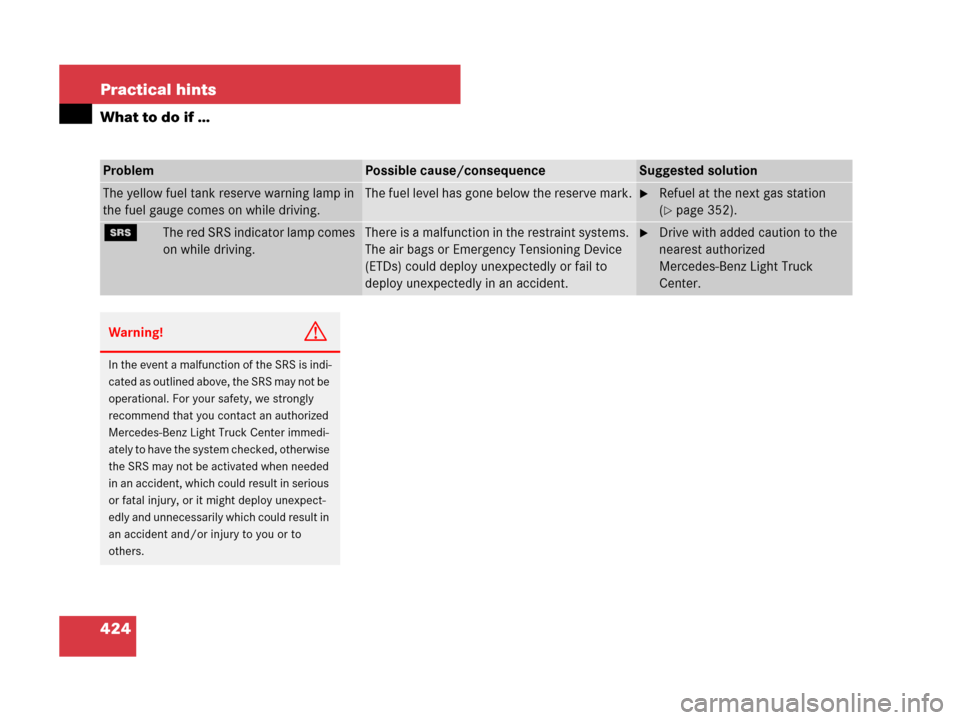
424 Practical hints
What to do if …
ProblemPossible cause/consequenceSuggested solution
The yellow fuel tank reserve warning lamp in
the fuel gauge comes on while driving.The fuel level has gone below the reserve mark.�Refuel at the next gas station
(
�page 352).
1The red SRS indicator lamp comes
on while driving.There is a malfunction in the restraint systems.
The air bags or Emergency Tensioning Device
(ETDs) could deploy unexpectedly or fail to
deploy unexpectedly in an accident.�Drive with added caution to the
nearest authorized
Mercedes-Benz Light Truck
Center.
Warning!G
In the event a malfunction of the SRS is indi-
cated as outlined above, the SRS may not be
operational. For your safety, we strongly
recommend that you contact an authorized
Mercedes-Benz Light Truck Center immedi-
ately to have the system checked, otherwise
the SRS may not be activated when needed
in an accident, which could result in serious
or fatal injury, or it might deploy unexpect-
edly and unnecessarily which could result in
an accident and/or injury to you or to
others.
Page 452 of 569
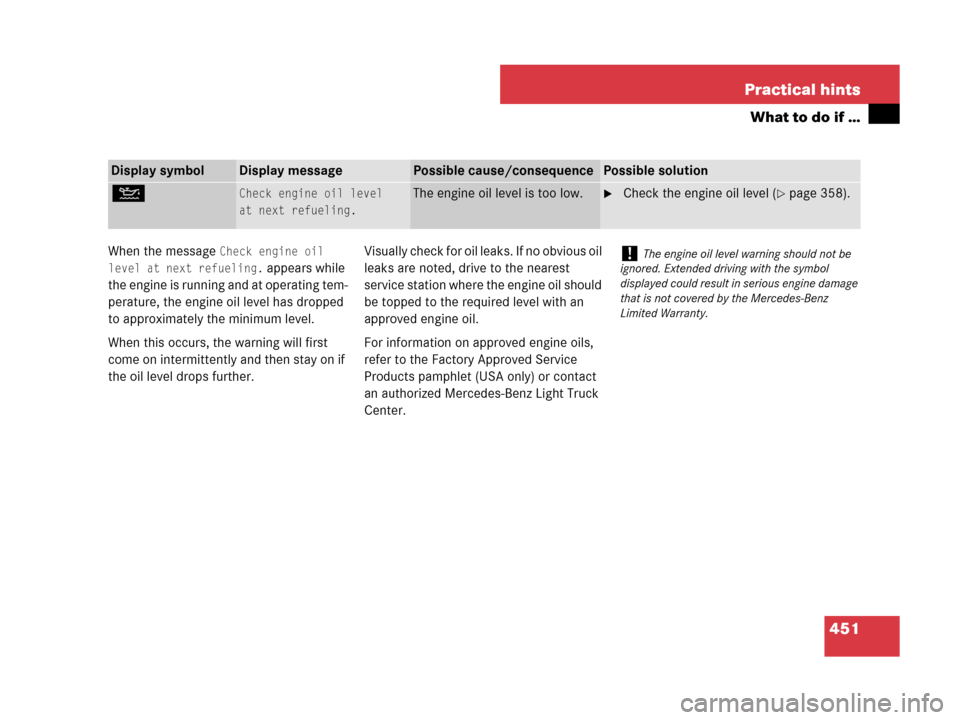
451 Practical hints
What to do if …
When the message Check engine oil
level at next refueling.
appears while
the engine is running and at operating tem-
perature, the engine oil level has dropped
to approximately the minimum level.
When this occurs, the warning will first
come on intermittently and then stay on if
the oil level drops further.Visually check for oil leaks. If no obvious oil
leaks are noted, drive to the nearest
service station where the engine oil should
be topped to the required level with an
approved engine oil.
For information on approved engine oils,
refer to the Factory Approved Service
Products pamphlet (USA only) or contact
an authorized Mercedes-Benz Light Truck
Center.
Display symbolDisplay messagePossible cause/consequencePossible solution
NCheck engine oil level
at next refueling.The engine oil level is too low.�Check the engine oil level (�page 358).
!The engine oil level warning should not be
ignored. Extended driving with the symbol
displayed could result in serious engine damage
that is not covered by the Mercedes-Benz
Limited Warranty.
Page 453 of 569
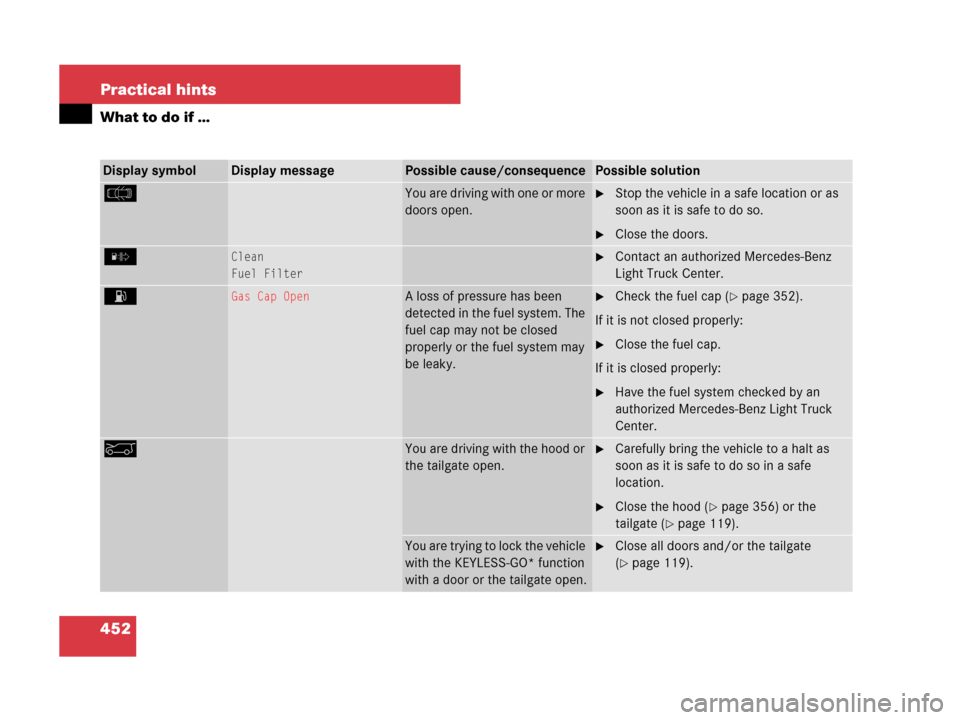
452 Practical hints
What to do if …
Display symbolDisplay messagePossible cause/consequencePossible solution
c You are driving with one or more
doors open.�Stop the vehicle in a safe location or as
soon as it is safe to do so.
�Close the doors.
]Clean
Fuel Filter�Contact an authorized Mercedes-Benz
Light Truck Center.
A Gas Cap OpenA loss of pressure has been
detected in the fuel system. The
fuel cap may not be closed
properly or the fuel system may
be leaky.�Check the fuel cap (�page 352).
If it is not closed properly:
�Close the fuel cap.
If it is closed properly:
�Have the fuel system checked by an
authorized Mercedes-Benz Light Truck
Center.
aYou are driving with the hood or
the tailgate open.�Carefully bring the vehicle to a halt as
soon as it is safe to do so in a safe
location.
�Close the hood (�page 356) or the
tailgate (
�page 119).
You are trying to lock the vehicle
with the KEYLESS-GO* function
with a door or the tailgate open.�Close all doors and/or the tailgate
(
�page 119).
Page 462 of 569

461 Practical hints
What to do if …
Display symbolDisplay messagePossible cause/consequencePossible solution
4Reserve FuelThe fuel level has gone below the reserve
mark.�Refuel at the next gas station
(
�page 352).
Ultra Low-sulfur
Diesel Fuel OnlyVehicles with diesel engine only:
The fuel level has gone below the reserve
mark.�Refuel at the next gas station
(
�page 352).
�Only use commercially available
vehicular ULTRA-LOW SULFUR
HIGHWAY DIESEL FUEL
(15 ppm SULFUR MAXIMUM).
L Tele Aid
InoperativeOne or more main functions of the
Tele Aid* system are malfunctioning.�Have the Tele Aid* system checked
by an authorized Mercedes-Benz Light
Truck Center.
Tele Aid
BatteryThe emergency power battery for the
Tele Aid* system is malfunctioning. If the
vehicle battery is also malfunctioning or
drained, Tele Aid* will not be operational.�Have the Tele Aid* system checked
by an authorized Mercedes-Benz Light
Truck Center.
tFunction
unavailableThis display appears if
buttontorson the multifunc-
tion steering wheel is pressed and the
vehicle is not equipped with a telephone.
WTop Up
Washer FluidThe fluid level has dropped to
about1/3of total reservoir capacity.
�Add washer fluid (�page 362).
Page 476 of 569
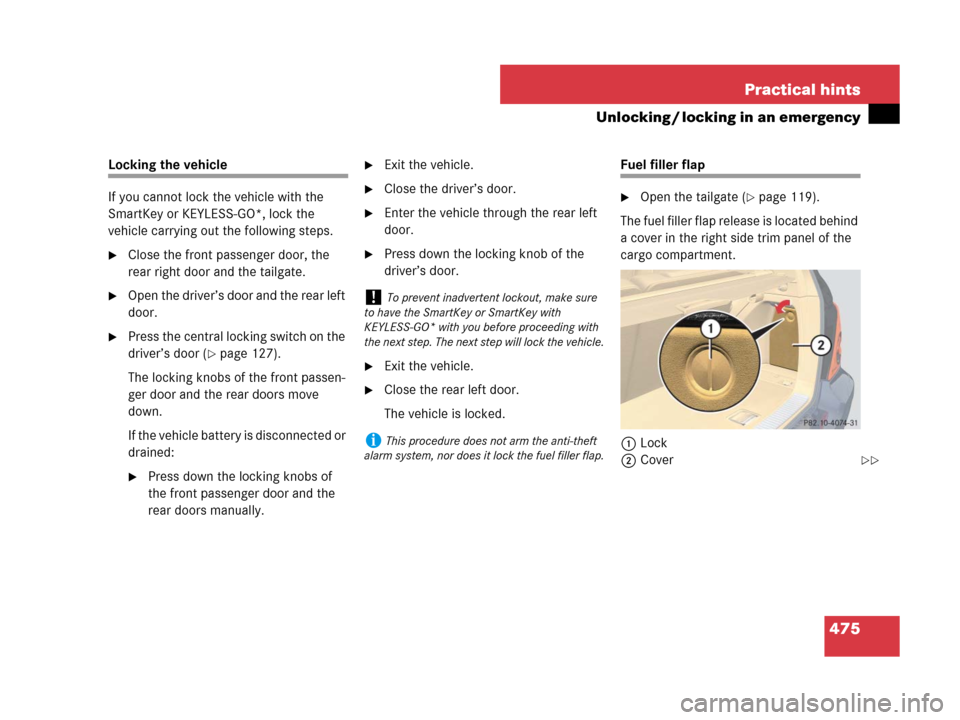
475 Practical hints
Unlocking / locking in an emergency
Locking the vehicle
If you cannot lock the vehicle with the
SmartKey or KEYLESS-GO*, lock the
vehicle carrying out the following steps.
�Close the front passenger door, the
rear right door and the tailgate.
�Open the driver’s door and the rear left
door.
�Press the central locking switch on the
driver’s door (
�page 127).
The locking knobs of the front passen-
ger door and the rear doors move
down.
If the vehicle battery is disconnected or
drained:
�Press down the locking knobs of
the front passenger door and the
rear doors manually.
�Exit the vehicle.
�Close the driver’s door.
�Enter the vehicle through the rear left
door.
�Press down the locking knob of the
driver’s door.
�Exit the vehicle.
�Close the rear left door.
The vehicle is locked.
Fuel filler flap
�Open the tailgate (�page 119).
The fuel filler flap release is located behind
a cover in the right side trim panel of the
cargo compartment.
1Lock
2Cover
!To prevent inadvertent lockout, make sure
to have the SmartKey or SmartKey with
KEYLESS-GO* with you before proceeding with
the next step. The next step will lock the vehicle.
iThis procedure does not arm the anti-theft
alarm system, nor does it lock the fuel filler flap.
��
Page 477 of 569
476 Practical hints
Unlocking / locking in an emergency
�Insert a suitable object such as a coin
into the slot of lock1.
�Turn lock1 counterclockwise by 90°
in direction of arrow.
�Remove cover2.
3Fuel filler flap release
�Pull red fuel filler flap release 3 in
direction of arrow.
The fuel filler flap is unlocked.
�Open the fuel filler flap (�page 352).
��